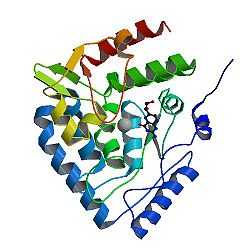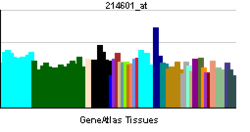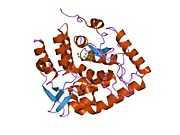TPH1
Tryptophan hydroxylase 1 (tryptophan 5-monooxygenase), also known as TPH1, is an enzyme which in humans is encoded by the TPH1 gene.[1]
TPH1 was first discovered to synthesize serotonin in 1988[2] and was thought that there only was a single TPH gene until 2003, while a second form was found in the mouse (Tph2), rat and human brain (TPH2) and the original Tph/TPH was then renamed to Tph1/TPH1.[3]
Function
Tryptophan hydroxylase (TPH; EC 1.14.16.4) catalyzes the biopterin-dependent monooxygenation of tryptophan to 5-hydroxytryptophan (5-HTP), which is subsequently decarboxylated to form the neurotransmitter serotonin (5-hydroxytryptamine or 5-HT). It is the rate-limiting enzyme in the biosynthesis of serotonin.
TPH expression is limited to a few specialized tissues: raphe neurons, pinealocytes, mast cells, mononuclear leukocytes, beta-cells of the islets of Langerhans, and intestinal and pancreatic enterochromaffin cells.[1]
Tph1 is not expressed in the mouse brain.[3]
Clinical significance
Tryptophan hydroxylase is important for the brain. However, Tph1 is not detected in the brain.[3] Nevertheless the effect of variations in the TPH1 gene on brain-related variables, such as personality traits and neuropsychiatric disorders, has been studied. For example, one study (1998) found an association between a polymorphism in the gene with impulsive-aggression measures,[4] while a case-control study (2001) could find no association between polymorphisms and Alzheimer's Disease.[5]
One human mutant of TPH1, A218C found in intron 7, is highly associated with schizophrenia.[6] Introns are regions of DNA that do not code for the amino acid sequence of a protein and were long considered to be 'junk DNA' lacking purpose. The correlation of an intron mutation with schizophrenia is significant because it suggests that introns have an important role in translation, transcription, or another, possibly unknown, aspect of the production of proteins from DNA.
See also
- Tryptophan hydroxylase
- Rs1799913 (A779C)
- rs1800532 (A218C)
References
- ↑ 1.0 1.1 "Entrez Gene: TPH1 tryptophan hydroxylase 1 (tryptophan 5-monooxygenase)".
- ↑ Finocchiaro LM, Arzt ES, Fernández-Castelo S, Criscuolo M, Finkielman S, Nahmod VE (December 1988). "Serotonin and melatonin synthesis in peripheral blood mononuclear cells: stimulation by interferon-gamma as part of an immunomodulatory pathway". J. Interferon Res. 8 (6): 705–16. doi:10.1089/jir.1988.8.705. PMID 3148005.
- ↑ 3.0 3.1 3.2 Walther DJ, Peter JU, Bashammakh S, Hörtnagl H, Voits M, Fink H, Bader M (January 2003). "Synthesis of serotonin by a second tryptophan hydroxylase isoform". Science 299 (5603): 76. doi:10.1126/science.1078197. PMID 12511643.
- ↑ New AS, Gelernter J, Yovell Y, Trestman RL, Nielsen DA, Silverman J, Mitropoulou V, Siever LJ (1998). "Tryptophan hydroxylase genotype is associated with impulsive-aggression measures: a preliminary study". Am. J. Med. Genet. 81 (1): 13–7. doi:10.1002/(SICI)1096-8628(19980207)81:1<13::AID-AJMG3>3.0.CO;2-O. PMID 9514581.
- ↑ Wang YC, Tsai SJ, Liu TY, Liu HC, Hong CJ (January 2001). "No association between tryptophan hydroxylase gene polymorphism and Alzheimer's disease". Neuropsychobiology 43 (1): 1–4. doi:10.1159/000054856. PMID 11150890.
- ↑ Allen NC, Bagade S, McQueen MB, Ioannidis JP, Kavvoura FK, Khoury MJ, Tanzi RE, Bertram L (July 2008). "Systematic meta-analyses and field synopsis of genetic association studies in schizophrenia: the SzGene database". Nat. Genet. 40 (7): 827–34. doi:10.1038/ng.171. PMID 18583979.
Further reading
- Li D, He L (2007). "Further clarification of the contribution of the tryptophan hydroxylase (TPH) gene to suicidal behavior using systematic allelic and genotypic meta-analyses.". Hum. Genet. 119 (3): 233–40. doi:10.1007/s00439-005-0113-x. PMID 16450114.
- Nielsen DA, Dean M, Goldman D (1993). "Genetic mapping of the human tryptophan hydroxylase gene on chromosome 11, using an intronic conformational polymorphism.". Am. J. Hum. Genet. 51 (6): 1366–71. PMC 1682899. PMID 1463016.
- Craig SP, Boularand S, Darmon MC et al. (1991). "Localization of human tryptophan hydroxylase (TPH) to chromosome 11p15.3----p14 by in situ hybridization.". Cytogenet. Cell Genet. 56 (3-4): 157–9. doi:10.1159/000133075. PMID 2055111.
- Boularand S, Darmon MC, Ganem Y et al. (1990). "Complete coding sequence of human tryptophan hydroxylase.". Nucleic Acids Res. 18 (14): 4257. doi:10.1093/nar/18.14.4257. PMC 331198. PMID 2377472.
- Ledley FD, Grenett HE, Bartos DP et al. (1987). "Assignment of human tryptophan hydroxylase locus to chromosome 11: gene duplication and translocation in evolution of aromatic amino acid hydroxylases.". Somat. Cell Mol. Genet. 13 (5): 575–80. doi:10.1007/BF01534499. PMID 2889273.
- Ichimura T, Uchiyama J, Kunihiro O et al. (1996). "Identification of the site of interaction of the 14-3-3 protein with phosphorylated tryptophan hydroxylase.". J. Biol. Chem. 270 (48): 28515–8. doi:10.1074/jbc.270.48.28515. PMID 7499362.
- Tipper JP, Citron BA, Ribeiro P, Kaufman S (1995). "Cloning and expression of rabbit and human brain tryptophan hydroxylase cDNA in Escherichia coli.". Arch. Biochem. Biophys. 315 (2): 445–53. doi:10.1006/abbi.1994.1523. PMID 7986090.
- Furukawa Y, Ikuta N, Omata S et al. (1993). "Demonstration of the phosphorylation-dependent interaction of tryptophan hydroxylase with the 14-3-3 protein.". Biochem. Biophys. Res. Commun. 194 (1): 144–9. doi:10.1006/bbrc.1993.1796. PMID 8101440.
- Kuhn DM, Arthur R, States JC (1997). "Phosphorylation and activation of brain tryptophan hydroxylase: identification of serine-58 as a substrate site for protein kinase A.". J. Neurochem. 68 (5): 2220–3. doi:10.1046/j.1471-4159.1997.68052220.x. PMID 9109552.
- Wang GA, Coon SL, Kaufman S (1998). "Alternative splicing at the 3'-cDNA of human tryptophan hydroxylase.". J. Neurochem. 71 (4): 1769–72. doi:10.1046/j.1471-4159.1998.71041769.x. PMID 9751214.
- Austin MC, O'Donnell SM (1999). "Regional distribution and cellular expression of tryptophan hydroxylase messenger RNA in postmortem human brainstem and pineal gland.". J. Neurochem. 72 (5): 2065–73. doi:10.1046/j.1471-4159.1999.0722065.x. PMID 10217286.
- Yu PL, Fujimura M, Okumiya K et al. (1999). "Immunohistochemical localization of tryptophan hydroxylase in the human and rat gastrointestinal tracts.". J. Comp. Neurol. 411 (4): 654–65. doi:10.1002/(SICI)1096-9861(19990906)411:4<654::AID-CNE9>3.0.CO;2-H. PMID 10421874.
- Kowlessur D, Kaufman S (1999). "Cloning and expression of recombinant human pineal tryptophan hydroxylase in Escherichia coli: purification and characterization of the cloned enzyme.". Biochim. Biophys. Acta 1434 (2): 317–30. doi:10.1016/S0167-4838(99)00184-3. PMID 10525150.
- McKinney J, Teigen K, Frøystein NA et al. (2002). "Conformation of the substrate and pterin cofactor bound to human tryptophan hydroxylase. Important role of Phe313 in substrate specificity.". Biochemistry 40 (51): 15591–601. doi:10.1021/bi015722x. PMID 11747434.
- Serretti A, Cristina S, Lilli R et al. (2002). "Family-based association study of 5-HTTLPR, TPH, MAO-A, and DRD4 polymorphisms in mood disorders.". Am. J. Med. Genet. 114 (4): 361–9. doi:10.1002/ajmg.10356. PMID 11992558.
- Slominski A, Pisarchik A, Semak I et al. (2002). "Serotoninergic and melatoninergic systems are fully expressed in human skin.". FASEB J. 16 (8): 896–8. doi:10.1096/fj.01-0952fje. PMID 12039872.
- Yohrling IV GJ, Jiang GC, DeJohn MM et al. (2002). "Inhibition of tryptophan hydroxylase activity and decreased 5-HT1A receptor binding in a mouse model of Huntington's disease.". J. Neurochem. 82 (6): 1416–23. doi:10.1046/j.1471-4159.2002.01084.x. PMID 12354289.
- Wang L, Erlandsen H, Haavik J et al. (2002). "Three-dimensional structure of human tryptophan hydroxylase and its implications for the biosynthesis of the neurotransmitters serotonin and melatonin.". Biochemistry 41 (42): 12569–74. doi:10.1021/bi026561f. PMID 12379098.
- Slominski A, Pisarchik A, Semak I et al. (2002). "Serotoninergic system in hamster skin.". J. Invest. Dermatol. 119 (4): 934–42. doi:10.1046/j.1523-1747.2002.00156.x. PMID 12406341.
- Ono H, Shirakawa O, Kitamura N et al. (2003). "Tryptophan hydroxylase immunoreactivity is altered by the genetic variation in postmortem brain samples of both suicide victims and controls.". Mol. Psychiatry 7 (10): 1127–32. doi:10.1038/sj.mp.4001150. PMID 12476329.
- Windahl MS, Petersen, CR, Christensen HEM, Harris P, (2008). "Crystal structure of tryptophan hydroxylase with bound amino acid substrate.". Biochemistry 47 (46): 12087–94. doi:10.1021/bi8015263. PMID 18937498.
| |||||||||


